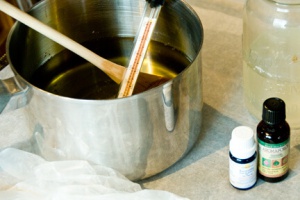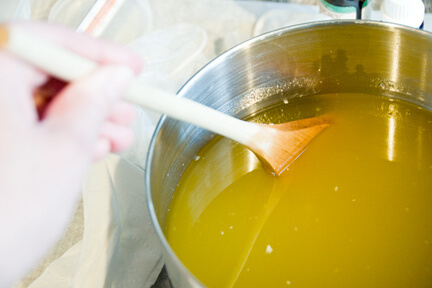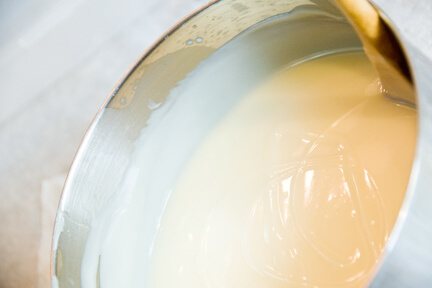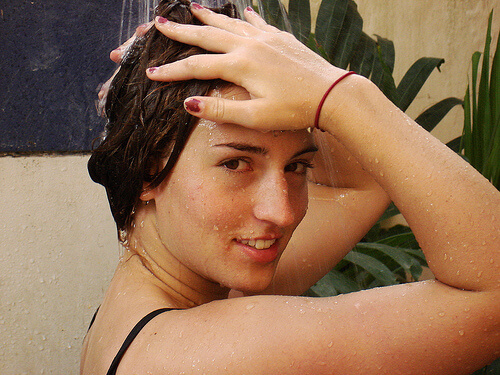How to Make Homemade Shampoo

Nowadays, most personal hygiene products contain chemicals and are synthetic. Thus, they are not very healthy for your body, your hair or your nails, etc. Do you want to know how to make a homemade shampoo?
Many of these products can go through our pores and into our bloodstream.
If you are in the market for a natural alternative to shampoo, read the following tips on how to make homemade shampoo.
See also: 5 Banana Masks to Make Your Skin and Hair Beautiful
Natural Shampoo Made out of Vinegar and Baking Soda
“Organic shampoos” are made from plant and natural ingredients. Their scent comes from essential oils, but they can be quite expensive.
But you don’t have to worry because we have another solution. We need to bring back the recipes our ancestors used for hygiene and health.
For instance, with apple cider vinegar and baking soda, you can clean your scalp and your hair in a matter of minutes with wonderful results.
You can also add certain essential oils in order to cover up the strong scent of vinegar.
Each one of these natural shampoo recipes works according to your need: tea tree oil works well for dandruff; rosemary oil works well for hair that is falling out, and lavender oil works well to relax your scalp.
How to do it:
Mix a tablespoon of baking soda with a glass of warm water until it is well dissolved. Fill a plastic bottle with this mixture (it can be an empty shampoo bottle).
If you have hair on the greasier side, add a bit more baking soda to the mixture. In a separate container, mix a cup of apple cider vinegar with a cup of water and fill another bottle.
This second mixture is the conditioner. If your hair is dry, add more vinegar.
To apply this shampoo and conditioner, you need to wet your hair and massage the first mixture softly into your hair. Then rinse your hair with warm water.
You might notice that your hair is a bit dry. Don’t worry because the conditioner will act to help balance the pH.
Apply the conditioner in the same way and rinse.
Take into account that during the first few days after using this shampoo and conditioner, your hair will need to adapt to this new way of washing it and generate its natural protective shield.
You might notice that your hair is greasier or has more dandruff for a few weeks.
Be patient and health will be returned to your hair, without a doubt.
Recipe for Homemade Shampoo Made from Aloe Vera
Aloe vera is an incredible plant with softening properties for your skin. That is why it is often used as the foundation for natural shampoo recipes.
You will need four ingredients to make this shampoo: glycerin (5ml), aloe vera gel (one tablespoon), liquid Castile soap (60 ml) and vegetable oil (1 ml).
You can find these ingredients in natural medicine stores. Aloe vera can be taken from the plant with a spoon.
In order to do so, cut one of the leaves and then separate the two parts longitudinally.
You can add some drops of essential oils to this shampoo to give it a nice aroma and also to help you with specific issues, such as hair loss, dandruff or dry scalp.
Mix all of the ingredients and put them into a container, mixing it with a spoon or a mixer. Afterward, you can add the essential oil of your preference.
This should give you about 120 ml of shampoo. Pour it into a plastic or glass bottle. You can use a funnel to make it easier to pour it into the bottle.
The important thing is for it to have a good top that closes well.
Save this bottle and use it each time you wash your hair.
You can use it every day, keeping in mind that for your scalp to be as healthy as possible, you should wet your hair every day and a half.
Before using your aloe vera shampoo, shake the bottle a bit because the ingredients can separate after several weeks.
See also: 3 Egg Remedies to Moisturize Dry Hair
Homemade Shampoo Recipe with Chamomile
It is likely that at one time, you have used chamomile to cleanse your hair.
The ingredients you will need for this marvelous recipe are:
- 1 liter of sodium lauryl ether sulfate;
- 1 cup of purified water;
- 20 grams of chamomile (or 4 bags of tea);
- 1/4 teaspoon of olive oil;
- 1/4 teaspoon of cetyl alcohol;
- 1 glass container that can hold 2.5 liters;
- funnel and a plastic bottle that can hold 1 liter.
Heat the water in a pot and when it starts to boil, prepare the infusion with chamomile, covered for five minutes to steep (with the stove turned off).
Add the cetyl alcohol and the oil. Turn the stove on to low heat until the first melts completely. Pour the sodium sulfate into the glass container and then add the previous mixture.
Shake it to create a homogeneous mixture.
Add the rest of the sulfate and lastly, pour the mixture into the plastic bottle, using the funnel as needed.
This homemade chamomile shampoo has a shelf life of 6 months and it must be stored in a cool area of the bathroom. You will spend 25% less than you would on a store-bought shampoo and at the same time, you will be using less toxic ingredients that are used to make products you can find a the store.
Homemade Shampoo Recipes with Honey
For this homemade shampoo, you will need liquid Castile soap, pure bee honey, and water.
Mix half of a cup of soap with half of a cup of water and 1 cup of honey in a bottle that has a screw-on cap. Softly shake the mixture so that the ingredients mix together properly.
Wash your hair as you would normally, leaving the mixture on your hair for about 10 minutes so that it takes effect.
Then rinse.
Another option is to mix 1/4 cup of honey, two tablespoons of water, 2 tablespoons of liquid Castile soap, 1 large egg, 1 tablespoon of witch hazel, 1 teaspoon of rosewater and 1 tablespoon of wheat germ.
Pour this mixture into the screw-cap bottle.
Apply to your hair as if it were normal shampoo.
Images courtesy of Kim, Jun Seita, Pete.
All cited sources were thoroughly reviewed by our team to ensure their quality, reliability, currency, and validity. The bibliography of this article was considered reliable and of academic or scientific accuracy.
- Schmidt-Rose, T., Braren, S., Fölster, H., Hillemann, T., Oltrogge, B., Philipp, P., … Fey, S. (2011). Efficacy of a piroctone olamine/climbazol shampoo in comparison with a zinc pyrithione shampoo in subjects with moderate to severe dandruff. International Journal of Cosmetic Science. https://doi.org/10.1111/j.1468-2494.2010.00623.x
- Trüeb, R. M. (2007). Shampoos: Ingredients, efficacy and adverse effects. JDDG. https://doi.org/10.1111/j.1610-0387.2007.06304.x
- Chiu, A. G., Palmer, J. N., Woodworth, B. A., Doghramji, L., Cohen, M. B., Prince, A., & Cohen, N. A. (2008). Baby shampoo nasal irrigations for the symptomatic post–functional endoscopic sinus surgery patient. American Journal of Rhinology. https://doi.org/10.2500/ajr.2008.22.3122
- Rahmani AH, Aldebasi YH, Srikar S, Khan AA, Aly SM. Aloe vera : Potential candidate in health management via modulation of biological activities. Pharmacognosy Reviews. 2015.
- Thornfeldt C. Cosmeceuticals containing herbs: fact, fiction, and future. Dermatologic surgery : official publication for American Society for Dermatologic Surgery [et al.]. 2005.
- Ediriweera ERHSS, Premarathna NYS. Medicinal and cosmetic uses of Bee′s Honey – A review. AYU (An Int Q J Res Ayurveda). 2012;
This text is provided for informational purposes only and does not replace consultation with a professional. If in doubt, consult your specialist.












